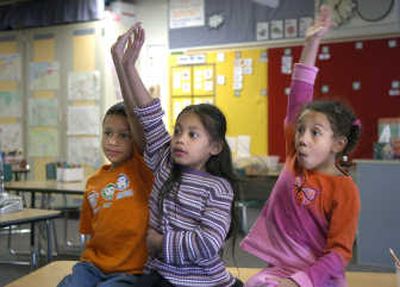Enrollment drop surprises schools

Spokane Public Schools is serving 851 fewer students than it did last year.
While more students are sure to arrive by the start of next month, the enrollment decline is still more than double what district officials were expecting. That means less money from the state, adding to existing budget problems in Eastern Washington’s largest school system.
And some teachers who were hired temporarily – but who may have hoped for permanent positions – will be sent home.
“We could not predict this,” said Mark Anderson, associate superintendent for school support services. “It’s troubling.”
The district expected to lose 330 students this year. Preliminary figures from the fourth day of school show an enrollment of 28,050 full-time students, for a loss of 851 students or about 3 percent.
No one is sure what caused the exodus. District officials blame changing demographics, in part, citing the growing number of families moving from urban to suburban areas, as well as the loss of affordable housing.
“But at this point nobody seems to have an explanation,” said Rona Williams, principal at Cooper Elementary School in northeast Spokane, which lost about 60 students.
Rogers High School is down about 40 students, and Shadle Park lost about 60. In fact, the freshman class in all six of the district’s high schools is down – by a total of about 200 full-time students. District officials think part of the problem could be fewer eighth-graders transferring from private parochial schools into public high schools.
But that doesn’t explain why there are nearly 100 fewer seniors than projected.
“If we haven’t talked about crisis before, it’s time to talk about crisis,” said Maureen Ramos, president of the Spokane Education Association, which represents 3,000 teachers.
Districts are funded by the state based on a formula that includes the number of full-time equivalent students. An average enrollment is calculated based on figures from the first of each month, and the funding is set in January.
While the district expects to add about 170 full-time students by Oct. 1 – typically used as the first official enrollment count – it won’t be enough. The unexpected drop could leave a $1.7 million budget hole, Anderson said.
About $1 million has already been filled by terminating the temporary teachers hired at the beginning of the school year, officials said.
“Now we have to go find $700,000,” Anderson said.
That won’t be easy considering district officials just made $10.8 million in cuts to this year’s $293 million budget, including closing Pratt Elementary School.
Since 2000, Spokane has experienced a steady enrollment decline, losing more than 2,000 students.
Meanwhile, Mead School District continues to grow, as does Central Valley School District. Deer Park is up by 30 students this year, at 2,300 full-time students.
Although it grew, Central Valley had fewer students walking through the doors than budgeted, a departure from its annual growth rate of 3 percent. Based on preliminary numbers from the first week of school, about 11,700 students enrolled. As in Spokane, that will grow some by Oct. 1. Overcrowding is still a problem in some Central Valley schools, leading the district to bus some students out of their neighborhoods, said Melanie Rose, district spokeswoman.
West Valley is up 107 full-time students over budget. About 25 new students enrolled at its newly remodeled high school.
A new Mead elementary school on Five Mile Prairie drew some Spokane students. Mead officials said more students than expected are enrolled in the new school.
“Some of those students were attending in Spokane and they lived up on the prairie,” said Wayne Leonard, executive director of business services for Mead.
Spokane school district data show that the biggest enrollment drops are in low-income neighborhoods and primarily in schools in northeast Spokane, adjacent to the Mead district.
In addition to Cooper Elementary, neighboring Logan Elementary School on Hamilton Street north of Mission Avenue lost 55 students – or two full classes. Arlington Elementary north of Francis Avenue lost 28 students. Whitman Elementary near Rowan Avenue and Crestline Street lost about 26 students.